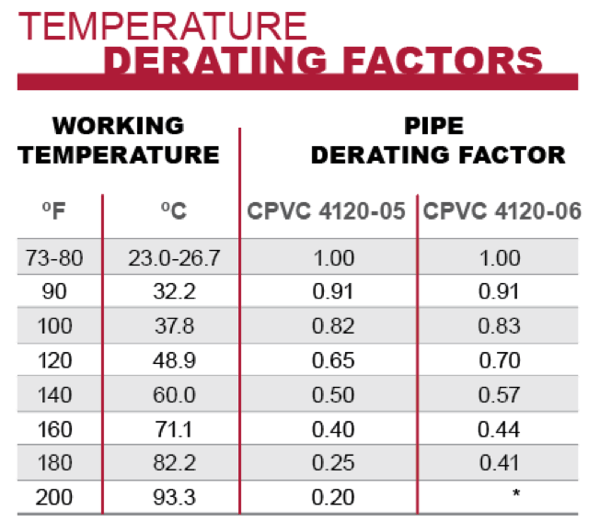By:
FlowGuard EMEA
on 05-mar-2020 1:15:00
CPVC Dos and Don’ts for HVAC Hydronic Applications
FlowGuard® CPVC pipe and fittings are designed to meet the temperature and pressure requirements of hydronic applications and withstand the internal stresses that result from conveying fluids over time at various temperatures. Adhering to the following guidelines will help ensure CPVC thermoplastic piping systems are designed and installed correctly for reliable performance in these complex projects.
“Dos” for Designing for Hydronic Applications
- Select a piping system with a maximum operating temperature of 82.2°C. FlowGuard CPVC piping may be installed in systems with an operating temperature up to 93.3°C. When working with temperatures from 82.2°C to 93.3°C, design criteria require the system’s operating pressure to be derated according to the pipe size used, per the chart below. Pressure ratings vary with schedule, pipe size, compound type and temperature.

*Consult with specific product or component manufacturers
for temperature derating factors above 93.3ºC
- Verify antifreeze compatibility and percentage. FlowGuard Piping Systems may be used to handle propylene glycol solutions up to 35 percent, methanol solutions up to 10 percent, and ethylene glycol or glycerin solutions at any concentration. Check the compatibility of other types of antifreezes or heat transfer fluids with the manufacturer prior to use.
- Compensate for the expansion of water and antifreeze. This is an industry best practice for all piping materials since water and antifreeze both expand when heated. Water expands at 4 percent and antifreeze expands at 12 percent. Using an expansion tank will compensate for these increases.
- Verify the compatibility of all boiler cleaning fluids or additives. FlowGuard CPVC has been used for decades in industrial process water applications handling chilled and boiler water treated with corrosion inhibitors, biocides and other types of treatment chemicals similar to those used for recirculating HVAC systems. No detrimental effects from such chemicals have ever been observed when these chemicals are applied at their recommended dosage rates. FlowGuard CPVC is not recommended for use as piping to dispense such chemicals in concentrated form into recirculating systems.
- Use only CPVC x metal threaded adapters. This is a recommendation for all systems with heated water. Expansion and contraction occur as the water is heated, and this movement could create a leak on plastic threads.
- Confirm pumps and other components are properly supported. Pumps are heavy and vibration that occurs during pumping can cause movement, which is why it is important to support pumps and other heavy metallic products such as expansion tanks when using CPVC piping.
- Verify the compatibility of all ancillary products used during piping system installation. The Lubrizol FBC™ System Compatibility Program eliminates the guesswork associated with researching the chemical compatibility of construction products that will be used during installation.
- Flush the interior of the heat exchanger or the exterior of condenser coils with a mild ionic detergent. An appropriate detergent to remove incompatible oils from heat exchangers and coils would be a 2 percent mix of trisodium phosphate (TSP).
“Don’ts” for Designing for Hydronic Applications
- Don’t use polyol ester (POE) oil as a compressor lubricant. While compressor lubricant should not normally enter the recirculating fluid in a properly operating system, it could be released into the recirculating fluid and/or condensate drain if a heat exchanger ruptures. POE oil use with CPVC has a history of causing pinhole leaks or damage to fittings. The industry has been moving toward using polyvinyl ester (PVE) oil as a substitute in these applications.
- Don’t use 100 percent CPVC threaded adapters. Use metal threaded adapters instead. Expansion and contraction occur as water heats, and this movement could create a leak on plastic threads.
- Don’t use compression fittings. Compression rings do not bind as well to plastic pipe as they do to copper and adding heated water can loosen the connection.
- Don’t use CPVC pipes or fittings to support pumps or other components. Pumps are heavy and vibration that occurs during pumping can cause movement. It is important to properly support pumps and other heavy metallic products such as expansion tanks when using plastic piping.
You can read about the value to engineers and plumbers alike of using lightweight, corrosion-resistant FlowGuard CPVC in hydronic applications here. Have questions as you are getting ready to start your next project? Contact us today.
.png)
-1.png)
